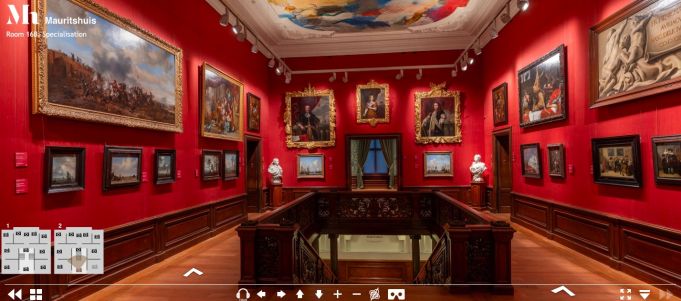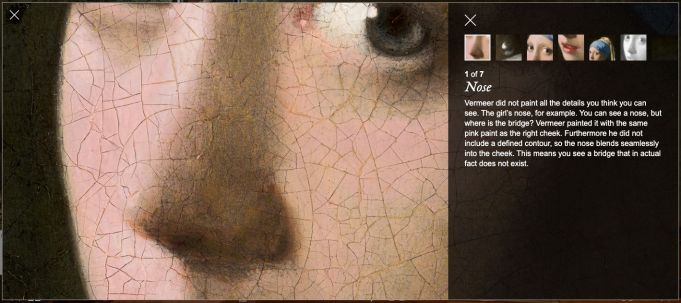The girl with the pearl earring as you've never seen her before
The Mauritshuis museum in The Hague, which houses Vermeer's famous painting, is one of first in the world to be fully digitized. Here's how (and what to see)
Like so many museums around the world, the Mauritshuis museum in The Hague, Netherlands, is not open right now. In recent months, similar to other art institutions, it has opened only briefly due to pandemic regulations. Temporary exhibitions and guided tours are suspended. Travel has become difficult.
But, the doors of what was once the magnificent, luxurious home of Count Johan Maurits van Nassau-Siegen in the 17th century are open just for you. You can start on the first floor, or climb the two carved wooden staircases leading to the upper floor.
You can wander through rooms carpeted in greenery, get up close to the paintings of one of the most incredible galleries in the world, and look closely, in blissful solitude, at some of the most famous paintings of the Dutch Golden Age.
Also read: Visiting the best European Museums Online
Some canvases, thirty- six to be precise, you can even see as only experts and restorers see them, magnified in maximum detail and even in infrared. These include all the Vermeers, four Rembrandts, three Jan Steens, Carel Fabritius's Goldfinch and Paulus Potter's The Bull. Among them, the spectacular View of Delft and the superstar who surpassed even the Mona Lisa in popularity: the Girl with a Pearl Earring, or Girl with Turban, which Vermeer painted in about 1665.
The digitilizing of the Museums

How is this possible? The museum has been completely digitized in giga pixel format (a giga pixel is an image of 1000 megapixels, more than 100 times the size of images produced by a smartphone), thanks to an app called Second Canvas. Or simply open the museum's website to unlock the kind of virtual tour you can take through the rooms, which is now truly an immersive experience. The technology opens up opportunities for both educational activities and research, as museum director Martine Gosselink, appointed shortly before the outbreak, explained in her presentation of the innovation.
Also read: Must see Museums in Copenhagen
The collaboration between Mauritshuis and Madpixel, the company behind Second Canvas, began a few years ago. In 2016, the Mauritshuis launched the Second Canvas app, which is now used by many other museums around the world. During the first lockdown last spring, Madpixel's robots took countless small images inside each room with 360-degree cameras.
The robots selected the resolution required for each artwork. The larger the painting, the higher the resolution must be to ensure an optimal millimeter-level "zoom experience." For the thirty- six works listed, it is also possible to switch between photographic and infrared images, uncovering the "secrets," preliminary drafts and in-progress corrections the artist made to the painting.
Go to the English version of the Mauritshuis website and choose "Start tour" to begin the visit. The best thing is to get a little lost, as if you really walked from one room to another without a map. But for those who like to get right to it, the indications are: room 15, Vermeer; room 14, Jan Steen and the Goldfinch by Fabricius; rooms 9 and 10, Rembrandt.
Also read: Main Museums in Rome
Take, for example, Veermer's View of Delft. As you approach the painting, you will find yourself where the painter wanted you to be - on the banks of the Scheda, on a bright spring or early summer morning. You will be able to appreciate how, as a virtuoso of the effects of light, the painter has painted the bell tower of the Neue Kirche with thick brushstrokes and the waters of the river more lightly, to give an effect of transparency.
The Girl with a Pearl Earring

Let us move on to the Girl with a Pearl Earring which is in the same room, just opposite. Staring closely at her delicately red mouth, you will discover that to illuminate it, bringing the viewer's attention to it, Veermer used the same white that gives life to the extraordinary pearl of the earring.
Move on to Rembrandt, in room number 9, and stop in front of Dr. Tulp's Anatomy Lesson (1632) the most important commission of his early career. You can get so close that you can almost make out the names of the commissioners, written in the book that the assistant holds behind the doctor. And then there are the discoveries.
The minor artists, those who (as in a real visit to a museum) would perhaps have escaped us in hastily flipping through a catalog, but who for some reason that we cannot explain, capture us as soon as we enter a room. Enter the second room, and pause in front of Still life with Five Apricots, by Adriaen Coorte.
Also read: Vatican Museums in Rome
Very little is known about him, except that he was a still life painter. Some of his works are kept at the Louvre, many in private collections. His value in recent years has risen a lot, perhaps for the elegance of the compositions, or for the exotic details, such as the small Oriental porcelain bowls, symbol of social life, travel, trade for the bourgeoisie of the time, and even today. Keep exploring. The museum is closed, but wonder is just a click away.
General Info
View on Map
The girl with the pearl earring as you've never seen her before
Mauritshuis, Plein, The Hague, Netherlands











